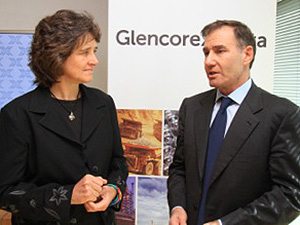
[miningmx.com] – IVAN Glasenberg’s GlencoreXstrata (Glencore) played the straightest of bats to questions following the R709bn group’s debut on the Johannesburg Stock Exchange (JSE), saying the risks of investing in South Africa had been over-stated.
The country’s union structures were also “mature”, and labour relations had “settled down significantly,” said the company’s executives.
Speaking to journalists at the JSE, Glasenberg said the regulatory environment in South Africa “… hasn’t been that bad … Every country does things: they change taxes and regulations. Countries are doing different things’.
Glasenberg’s comments are in the context of two volatile years in South Africa’s mining sector characterised by labour strife and regulatory uncertainty.
For instance, proposed amendments to the Minerals & Petroleum Resources Development Act (MPRDA) envisage giving government broad-based discretion over minerals it identifies as strategic, such as coal.
Clinton Ephron, a Glencore coal executive, echoed comments by the Chamber of Mines earlier this month, saying there were not many loose ends regarding negotiations over the MPRDA amendments. “Most issues in the MPRDA been dealt with, and we are trying to come to terms with outstanding issues. I think we can come to an amicable win-win,’ said Ephron.
Head of Glencore’s ferroalloys mining businesses, Gary Nagle, who with communications head, Paul Smith, also represents the Swiss-headquartered firm on Lonmin’s board, said the labour environment in South Africa had “settled down significantly.
“We’ve been through tough times. Unions need to understand that they need to play by the house rules,’ he said. In July, Glencore fired 1,000 workers at three of its chrome mines in the Limpopo province for embarking on an illegal strike.
Nagle said that compared to countries in South America, South Africa’s unions were mature. “It’s an issue of engagement with unions and working directly with the work force,’ he said. “It’s a risk, but one that can be managed with support from the government and proper relationship with unions.’
Glasenberg acknowledged, however, that the South African government’s intervention in cost-cutting drives was a worry. “If you can’t reduce your cost, it does become a concern. We have a duty to show that we are profitable,’ he said.
Earlier this year, the government intervened in plans by Anglo American Platinum (Amplats) to restructure its workforce in Rustenburg. Amplats said the engagement was constructive, and did not change its end-game.
Glencore’s listing in Johannesburg naturally raised speculation its presence would pave the way for merger and acquisition activity, specifically a bid for Anglo American which at about R333bn is valued at approximately half Glencore.
Glasenberg said there was no appetite for assets it could not trade. “We would look at another company that holds stuff we don’t trade. You can make your own assessment from that,’ he said. Anglo American owns about 78% of Amplats. Glencore is also a seller of its 24% stake in Lonmin.
Glencore’s stock opened at about R55/share, and traded pretty much in line with London where it has its primary listing. The Johannesburg listing followed discussions with investors in February who said there would be interest in Glencore’s diversity: for instance, it does not hold iron ore unlike BHP Billiton and Anglo American.











